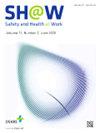从事什么工作最危险?厄瓜多尔经济活动风险水平评估
IF 2.9
3区 医学
Q1 PUBLIC, ENVIRONMENTAL & OCCUPATIONAL HEALTH
引用次数: 0
摘要
对经济活动进行风险等级分类是世界上一些国家所遵循的职业健康和安全做法。它允许政府机构根据每项活动的需要制定具有职业风险预防要求的公共政策。此外,这种风险水平直接影响到公司根据其活动的危险性向公共或私营职业风险保险公司缴纳的费用。在厄瓜多尔,一个专家委员会根据行政数据对经济活动的风险等级进行了分类。但是,这种分类因缺乏客观性和使用行政记录而受到质疑,其中少报的情况限制了数据的准确性和全面性。方法:这项横断面、描述性和比较性研究使用了全国就业、失业和就业不足调查(ENEMDU)的数据。根据风险水平,对经济活动造成的伤害和疾病发生率的估计分为三组(高、中、低)。结果获得了一种新的经济活动风险分类方法,并与现有分类方法进行了比较。结论sour结果有助于减轻当前经济活动风险分类缺乏方法严谨性的不确定性,并评估使用ENEMDU调查数据的相关性。它们还允许比较从不同方法和数据来源开发的两种风险分类。从实践的角度来看,研究结果将有助于决策者澄清职业安全与健康(OSH)政策的现行法规。本文章由计算机程序翻译,如有差异,请以英文原文为准。
What Activity is the Most Dangerous to Work in? Estimation of the Risk Level of Economic Activities in Ecuador
Background
Classifying economic activities into risk levels is an occupational health and safety practice that several countries worldwide observe. It allows government agencies to formulate public policies with occupational risk prevention requirements tailored to each activity's needs. Further, this level of risk directly influences companies' contributions to occupational risk insurers, whether public or private, according to the dangerousness of their activity. In Ecuador, the classification of economic activities into risk levels was carried out by a Committee of Experts based on administrative data. However, this classification has been questioned for its lack of objectivity and for using administrative records, where underreporting cases limit the accuracy and comprehensiveness of the data.
Methods
This cross-sectional, descriptive, and comparative study uses data from the National Survey of Employment, Unemployment, and Underemployment (ENEMDU). Estimates of the incidence rates of injuries and illnesses by economic activity were grouped into three clusters (high, medium, and low) according to the level of risk.
Results
An alternative risk classification of economic activities was obtained and compared with the existing classification.
Conclusions
Our results help mitigate the uncertainty in the current risk classification of economic activities' lack of methodological rigor and evaluate the relevance of using data from the ENEMDU survey. They also allow a comparison of two risk classifications developed from different methodologies and data sources. From a practical perspective, the results will help decision-makers clarify current regulations in Occupational Safety and Health (OSH) policies.
求助全文
通过发布文献求助,成功后即可免费获取论文全文。
去求助
来源期刊

Safety and Health at Work
Social Sciences-Safety Research
CiteScore
6.40
自引率
5.70%
发文量
1080
审稿时长
38 days
期刊介绍:
Safety and Health at Work (SH@W) is an international, peer-reviewed, interdisciplinary journal published quarterly in English beginning in 2010. The journal is aimed at providing grounds for the exchange of ideas and data developed through research experience in the broad field of occupational health and safety. Articles may deal with scientific research to improve workers'' health and safety by eliminating occupational accidents and diseases, pursuing a better working life, and creating a safe and comfortable working environment. The journal focuses primarily on original articles across the whole scope of occupational health and safety, but also welcomes up-to-date review papers and short communications and commentaries on urgent issues and case studies on unique epidemiological survey, methods of accident investigation, and analysis. High priority will be given to articles on occupational epidemiology, medicine, hygiene, toxicology, nursing and health services, work safety, ergonomics, work organization, engineering of safety (mechanical, electrical, chemical, and construction), safety management and policy, and studies related to economic evaluation and its social policy and organizational aspects. Its abbreviated title is Saf Health Work.
 求助内容:
求助内容: 应助结果提醒方式:
应助结果提醒方式:


